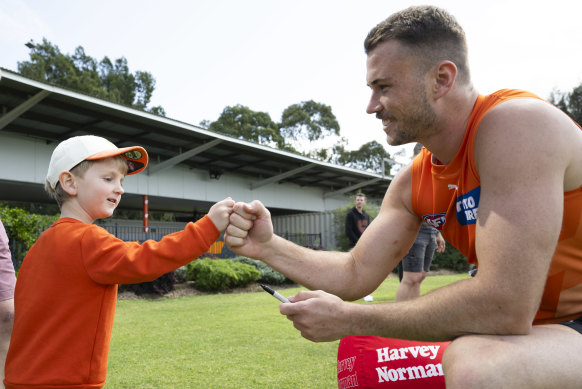‘Not where we want to be’: AFL booming in Swans territory, but it’s a different story out west

- by Admin
- September 13, 2024

Other clubs have banded together and formed ‘alliances’ between clubs in the same region. As an example, the Penrith Giants, Hawkesbury Saints and the Mountain Lions of Faulconbridge will field separate teams up to the age of 13, but beyond that, those clubs will funnel their players into a single team; as the number of players on the field increases in accord with the age groups, they have little choice.
Loading
“In the 13-18 age group, all across western Sydney and some other areas of Sydney, a lot of clubs like ours are forming alliances with other clubs,” Penrith Giants coaching coordinator Mick Pearson told the Western Weekender earlier this year. “This is new for us due to the decline in this area.”
Increased travel, due to these shifts in community football, have added to the strain, to the point where some talented players as young as 14 have decided to move interstate in pursuit of better week-in, week-out exposure. Cost of living is another pressure, not to mention the pandemic, which had an impact on participation across all sports, but perhaps Aussie Rules more than any other in the west.
Rob Auld, the AFL’s executive general manager of game development, acknowledges that the community game in western Sydney is lagging and wants to help get it back on track. The AFL is expected to shortly install eight more game development officers in Sydney, with half of them to be dedicated to the west, to help lighten the load on an otherwise largely volunteer-based workforce.
“I would say at a community level, we’re starting to put some activities in place that the market is responding to, but we’re not where we want to be,” Auld said.
“Leading into the period of 2021 we had good momentum, and then we were out of the market for two years [with COVID-19] and then in 2022 it was one of the wettest years on record in Sydney, I think that set us back in the sense of the game was growing, but it wasn’t foundational in its roots, and so those headwinds did create pressure on our club network, no question.
“But what it hasn’t done is it hasn’t deterred or it hasn’t diminished the AFL’s commitment to wanting to be a truly national game, and it certainly hasn’t deterred or diminished our commitment to growing the game in western Sydney.”
Tackling the ‘nuances’ of the west
Grassroots figures are also dissatisfied with some symbolic decisions by the Giants, which they say raise questions over their commitment to western Sydney. For the current AFLW season, the Giants’ six home games will be split between Canberra’s Manuka Oval (two) and Henson Park in Newtown. None will be played at the purpose-built facility in Blacktown; some years ago, the Giants’ men’s program also shifted from there to Olympic Park.
Darcy Jones and Callan Ward at training this week in SydneyCredit: Janie Barrett
It remains an uphill battle attracting fans through the turnstiles at Engie Stadium to see the Giants. The club benefited from the AFL’s decision to start the 2024 season with Opening Round, enjoying a rare sell-out against Collingwood. But GWS still have the lowest attendance in the AFL, with an average of 12,275 for home games this season, which is down from their 2017 peak of 13,196 but still competitive with many NRL teams in Sydney.
To help combat these challenges, the AFL has this year invested in a ‘fan hub’ to help spark interest in the code across the western suburbs. Asked how he would describe the initiative to someone from the area, James Ellender, the head of the ‘fan hub’, said: “A bespoke marketing, data and sales team who are working hand in glove with the code to grow the game, and we move from week to month to place to place to put the best version of ourselves forward in the most competitive market in the country.”
As part of their remit, the hub partners with local schools and teachers in western Sydney and buses up 200 kids and their families from Parramatta and Hurstville to Giants and Swans games. There are multilingual cheat sheets for the rules and rehearsals of the club’s song en route to the game.
Auld admits the AFL has had to completely rethink its approach to western Sydney from its previous efforts in growing the game which took more of a blanket approach. There is now an individual strategy from the AFL for 10 specific LGAs in the region.
“I think we may have been not as quick to recognise that we need to be quite nuanced, quite specific and quite bespoke about how we reach into the hearts and minds of our Western Sydney audience,” Auld said.
“I would say we’re taking a much more bespoke, sophisticated approach to the market. We’re doing it in an incredibly integrated way with the clubs, AFL NSW and the fan hub. We’ve got green shoots, but we understand that it is not off a base that we think is at a level that we’re comfortable with, we’ve got a lot of work to do, but we are seeing positive responses to what we are doing.”
Michael Bright, the president of the Parramatta Goannas club who has been heavily involved with the game in western Sydney for the past 11 years, warned “people can’t attach themselves to a brand that isn’t present in the community their brand was born in”. He called for the Giants’ men’s team to make an annual return to Blacktown against a lower-drawing team they’d otherwise face at Engie Stadium.
“We’d love to see them more present in the west,” he said. “We have the most dense population in the country wanting attention, and a packed Engie Stadium, which we all want, only happens if they are present in the western Sydney community.”
Rugby league’s resurgence
Hunter Fujak is a lecturer in Sports Management at Deakin University in Melbourne and has extensively studied the complex sporting market of western Sydney. He believes the Giants’ tenuous hold needs to be set into the context of the Swans’ long path to success since their relocation in 1982.
“The timeline that we measure success for the Giants really needs to be generational rather than even 10 years, 15 years,” Fujak said.

Kieren Briggs with a young fanCredit: Janie Barrett
But the landscape has shifted. When the Giants began in 2012, rugby league was at a low ebb, particularly in the western suburbs.
“It’s actually remarkable how much rugby league has grown in the past three, four years, especially with Penrith doing really well, Parramatta building a new stadium from which they’ve been able to offer a better game-day experience,” he said. “The Bulldogs as well, obviously now coming back – probably the bigger part is that ultimately [the Giants] are still competing in a really contested market with their major competitor being resurgent.”
Giants chief executive Dave Matthews has been with the club since its inception and also recognises the NRL has grown even more sophisticated during that time, but is still confident his club can remain good neighbours with rugby league.
“I just think they’re [the NRL] doing things better than probably what they did previously,” Matthews said. “And what I mean by that is I think they’ve got better stadiums now, I think they’ve got a really strong offering for women and girls, State of Origins are an enormous beast.
“I think there’s absolutely room in a market of Sydney’s size for the NRL clubs to thrive and for Sydney and the Giants to also thrive. I don’t necessarily think we compete head-to-head – in fact, our proposition in Western Sydney in particular is probably: you can barrack for Penrith Panthers, you can barrack for Parramatta Eels, you can barrack for any of the other NRL clubs, but the AFL club for the people of Western Sydney is the Giants.”
Fujak commends the Giants for the way they have sought to differentiate themselves from the Swans, using social media to position their club as a cheeky, irreverent challenger brand to their established rivals, and one that is more likely to win over younger people.
“They basically consciously try to piss off other teams’ fans. They’ve been really clever, and I think that’s really helping them carve out a space,” Fujak said.
“You’re probably never going to get a 50-year-old rusted on Eels fan, right? That person’s probably made their choice. They’re not going to switch. And so what is interesting is the social media stuff obviously is way more predisposed to young audiences, which again speaks to the generational strategy that they have to adopt, rather than a right here, right now, today strategy.”
Showcasing the Showground
Matthews’ ambitions for the Giants are significant. In time he believes they could become one of the biggest clubs in the AFL. The club’s membership is at its highest yet of 36,629, but the number has not consistently translated into home games; a decent chunk of them are Canberra-based.
The key, Matthews said, is working closer with the AFL to ensure that each fixture is maximised to its full extent.
Loading
“I think Sydney generally is an events market,” Matthews said. “So what we see is when the fixtures are put on at the right time, and our best time slot is probably Saturday twilight – if we’ve got the right time slot, then we see a real spike in members not just wanting to go, but being able to go.
“First and foremost, the membership number for us is an indication of the support and connection that the club has generally, and then the challenge is: how do you translate that into as many people coming to the games as you can?”
While Fujak tends to dismiss membership figures as “propaganda tools” for sporting bodies, he said the Giants deserve credit for growing their wider fanbase, although he doubts if there will be a singular moment – like the Swans’ 1996 grand final appearance – which will be looked back upon as the moment things truly clicked for them in Sydney.
“It’s hard to know whether it would be that one spark that causes it. I don’t think that will be the case anymore,” he said. “The Swans back then were in a different environment than the Giants are now. But certainly, success will lead to iterative growth.”
The Latest News
-
November 23, 2024Tennis world loses it after Novak Djokovic shares ‘best news’
-
November 23, 2024Australian cricket great slams ‘unacceptable’ scenes as India takes stranglehold on Test
-
November 23, 2024‘Welcome aboard’: Djokovic unveils old rivals as new coach
-
November 23, 2024Davis Cup: Australia falls just short of third consecutive final
-
November 23, 2024Australian Fashion Industry’s Best of 2024 Celebrated in Sydney – Travel And Tour World


